One of the best ways to foster an empowering workplace environment is by recognizing an employee’s hard work and dedication. By explicitly pointing out that a worker’s efforts are appreciated, overall employee morale will stay high, and employees will be motivated. But it can be difficult for managers to appropriately express that level of appreciation, which is where letters of recognition come in. Learning to demonstrate recognition in a straightforward letter is a great way to show workers that they’ve been noticed. This article will go through everything; an employer needs to know about employee recognition letters and exactly how to write them.
An employee recognition letter is, at its core, a thank you letter. You’re writing a letter to your employees and thanking them for their hard work and dedication. This can come in various situations in the workplace and should be customized to fit the situation at hand.
Sample Letters
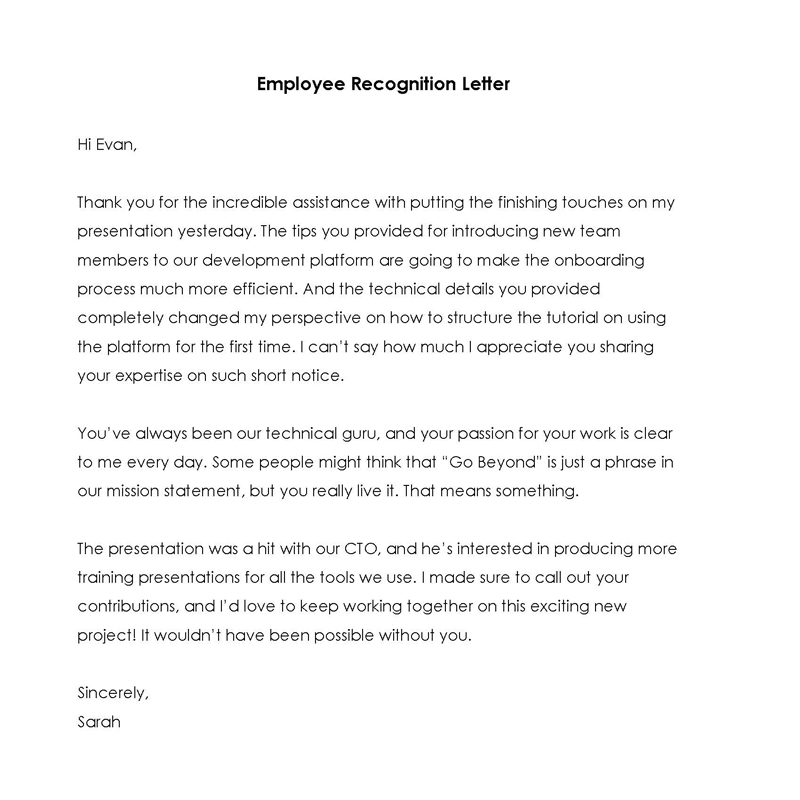
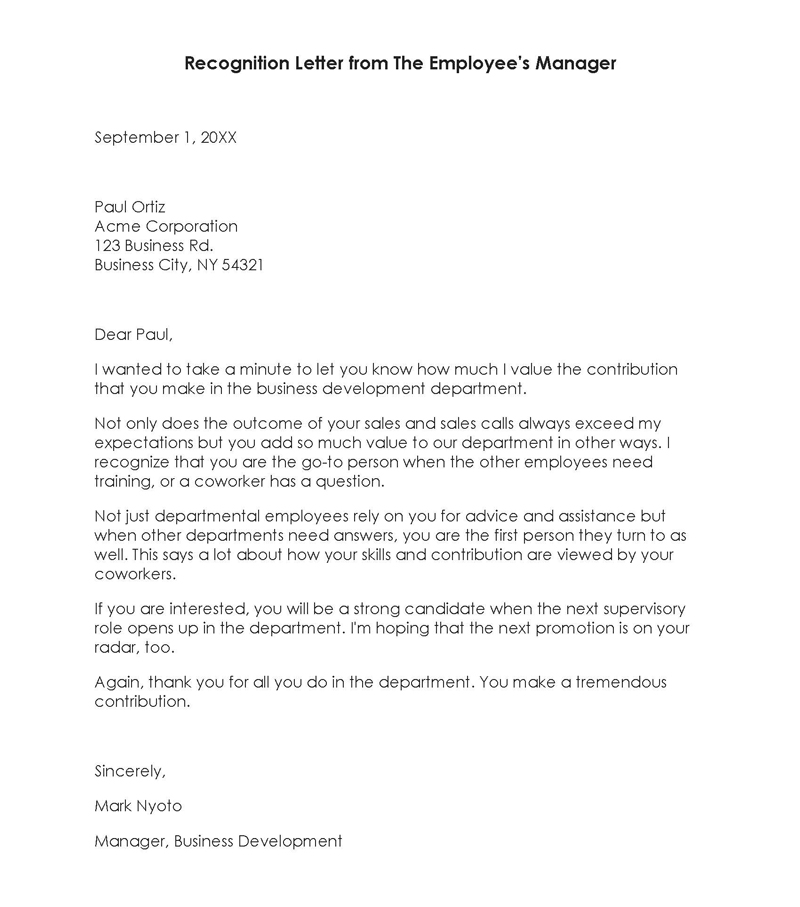
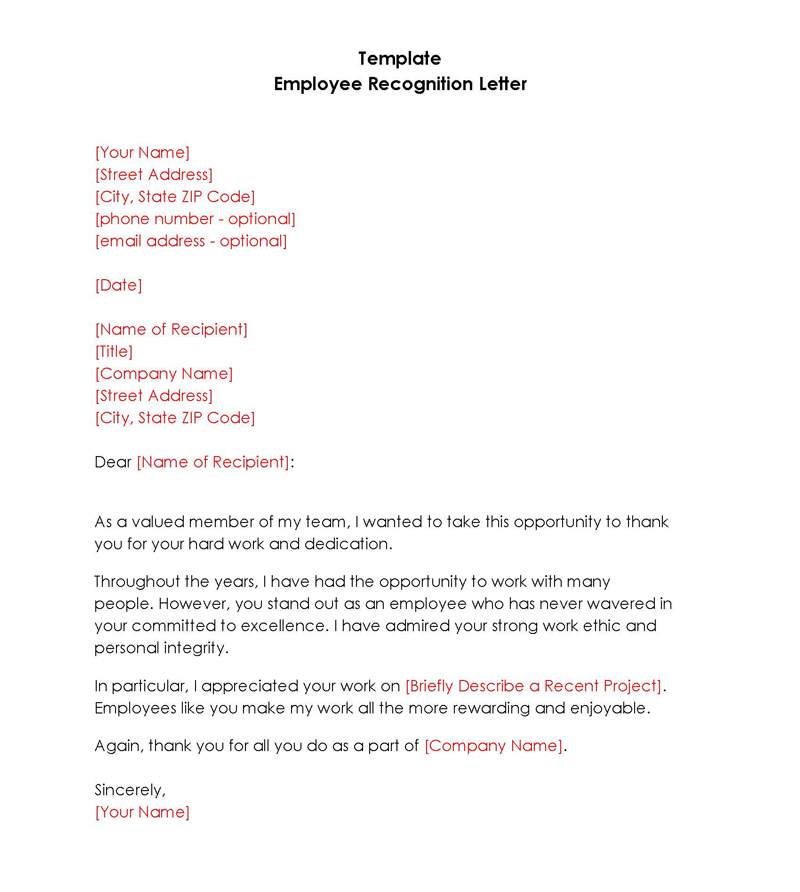
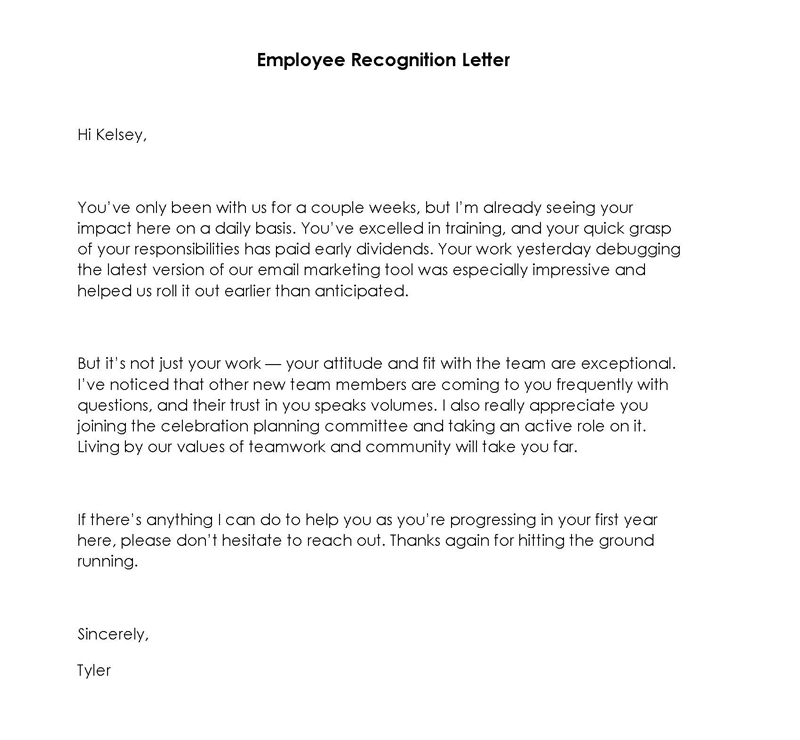
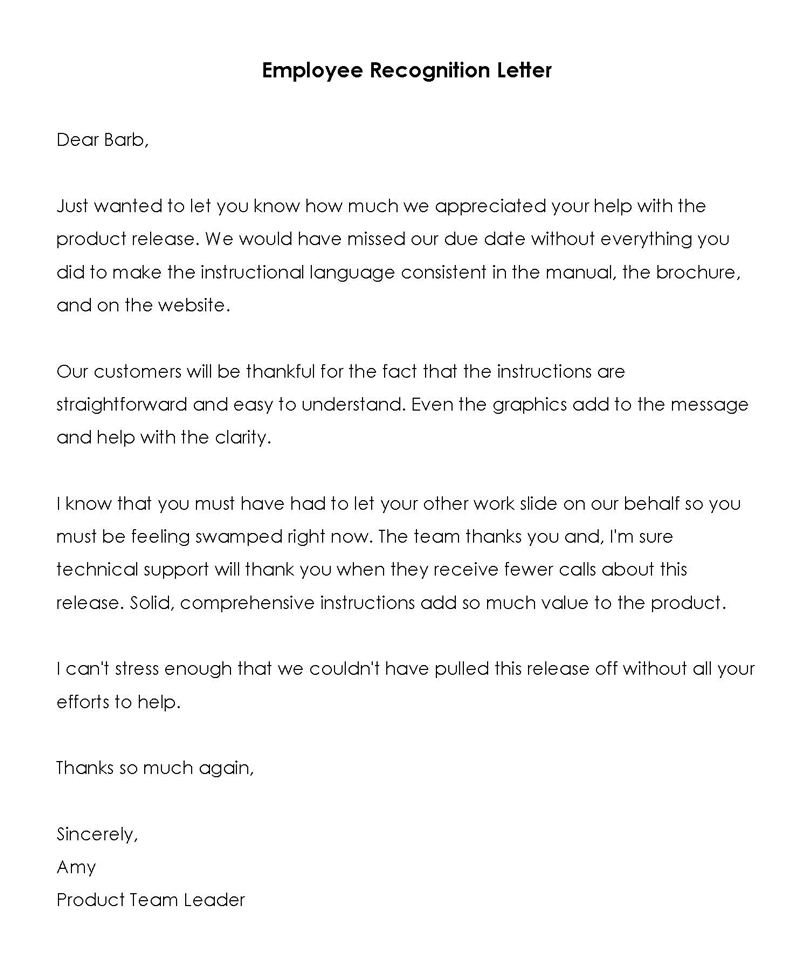
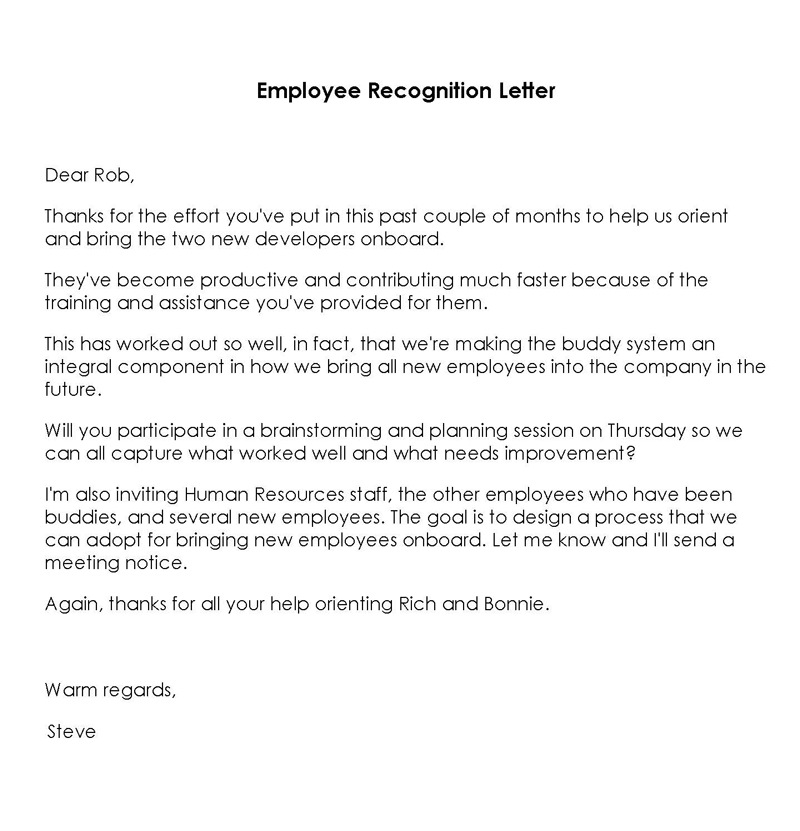
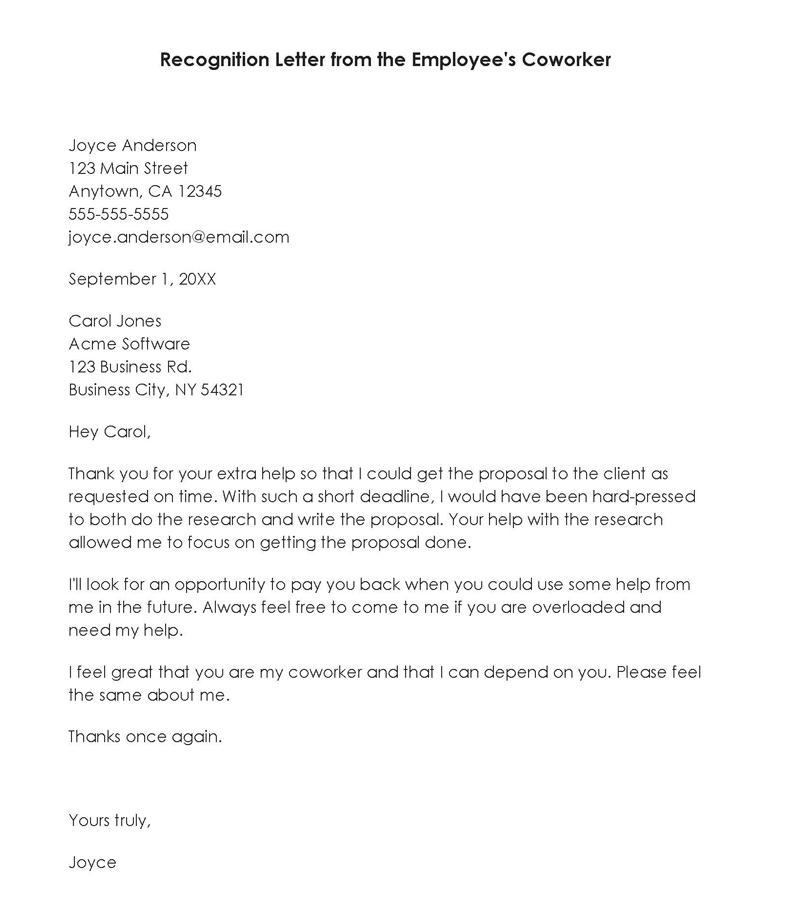
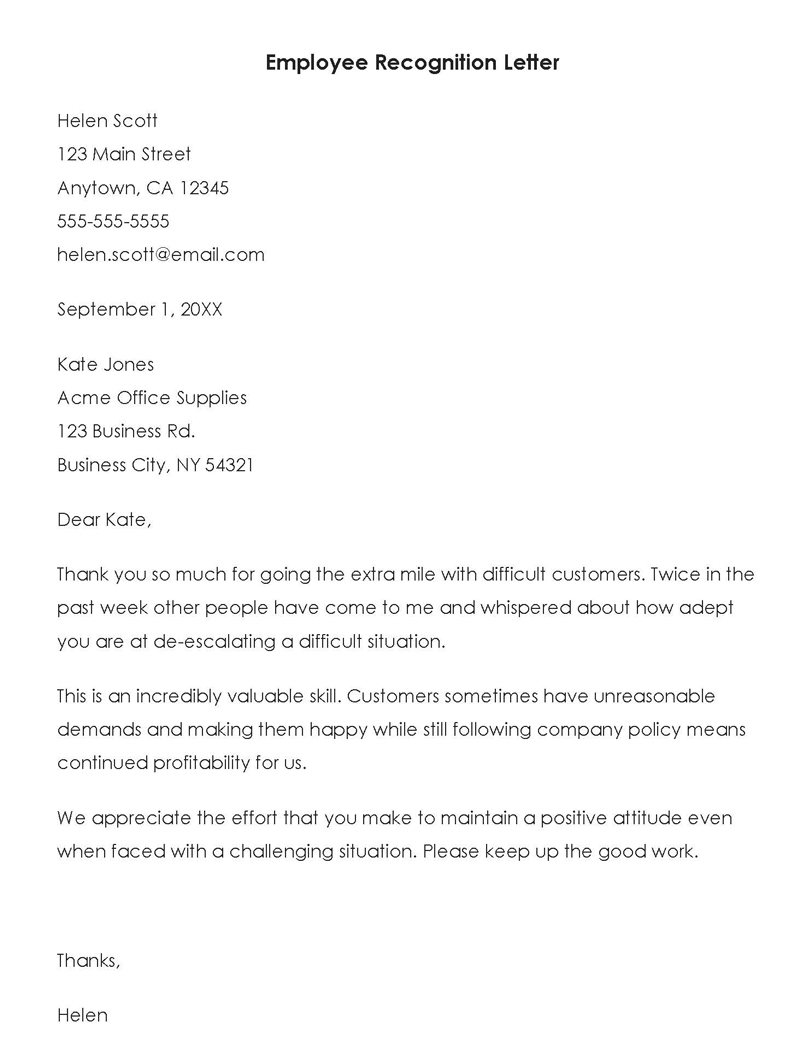
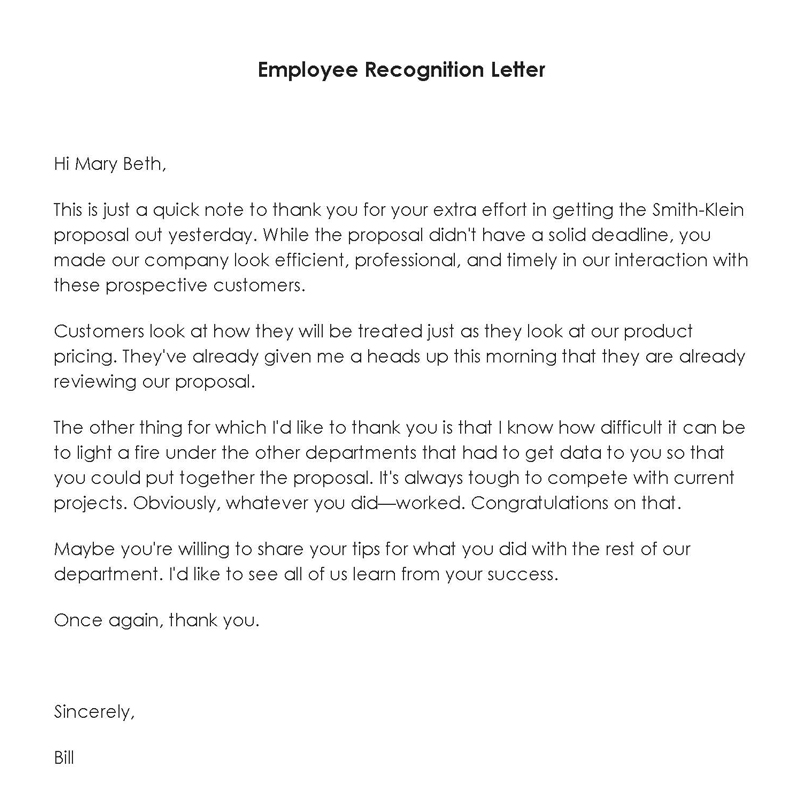
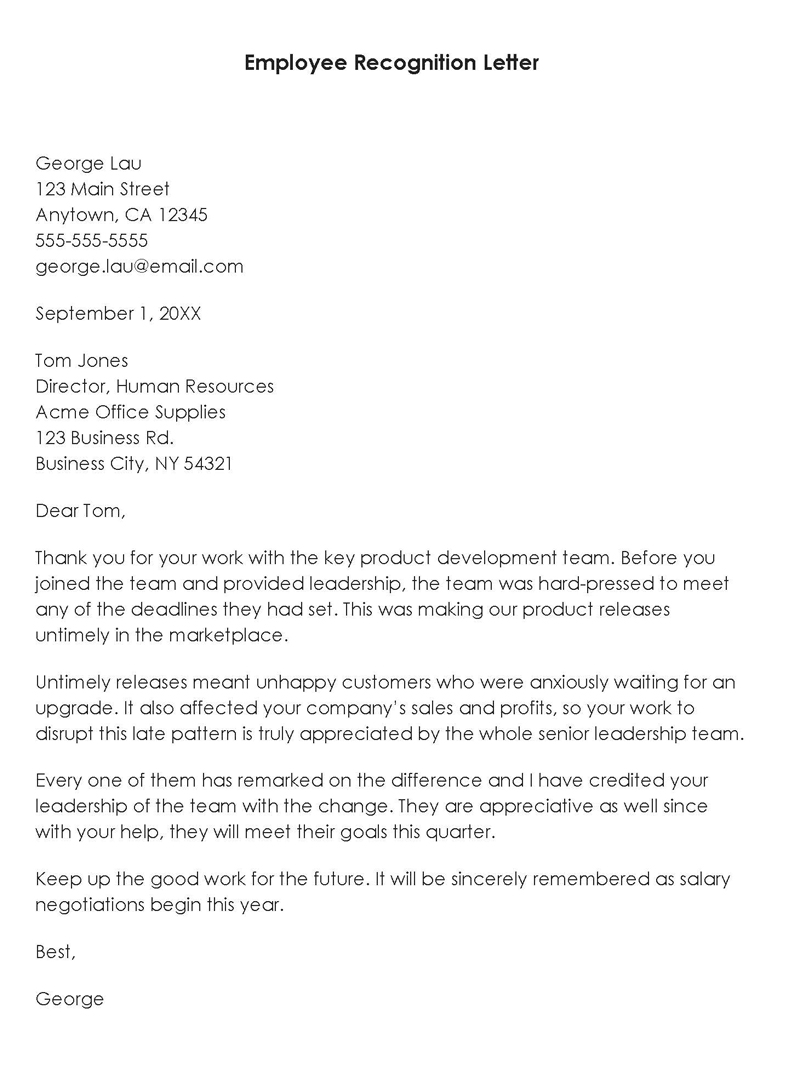
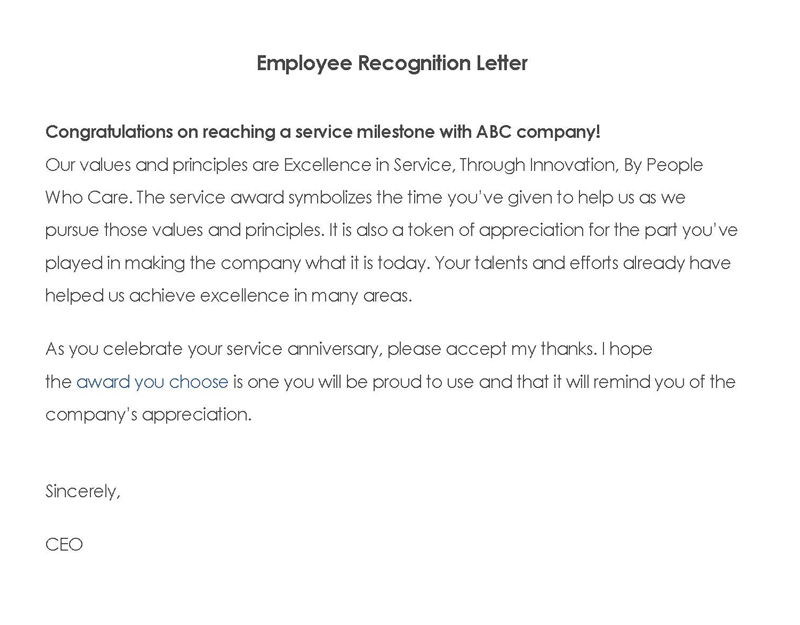
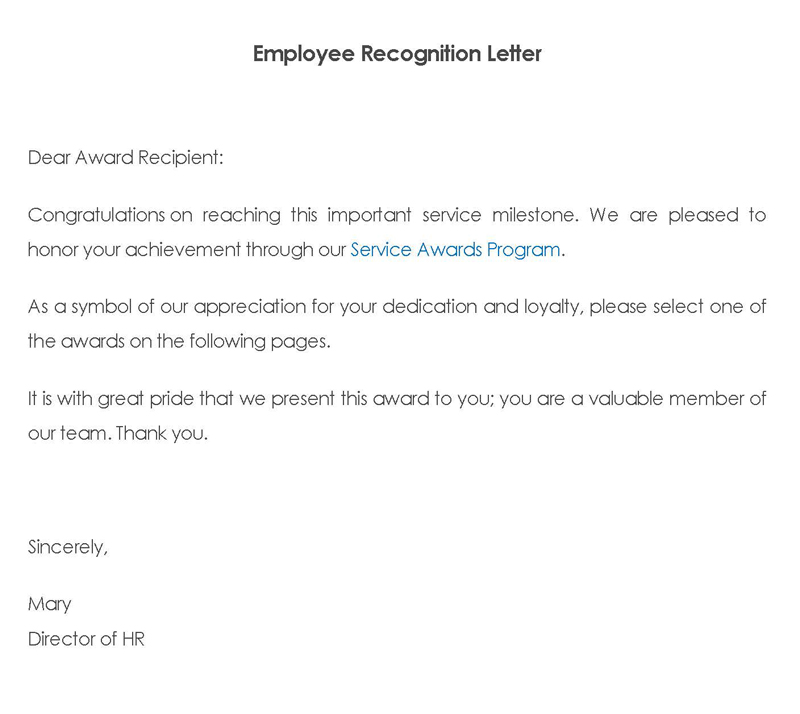
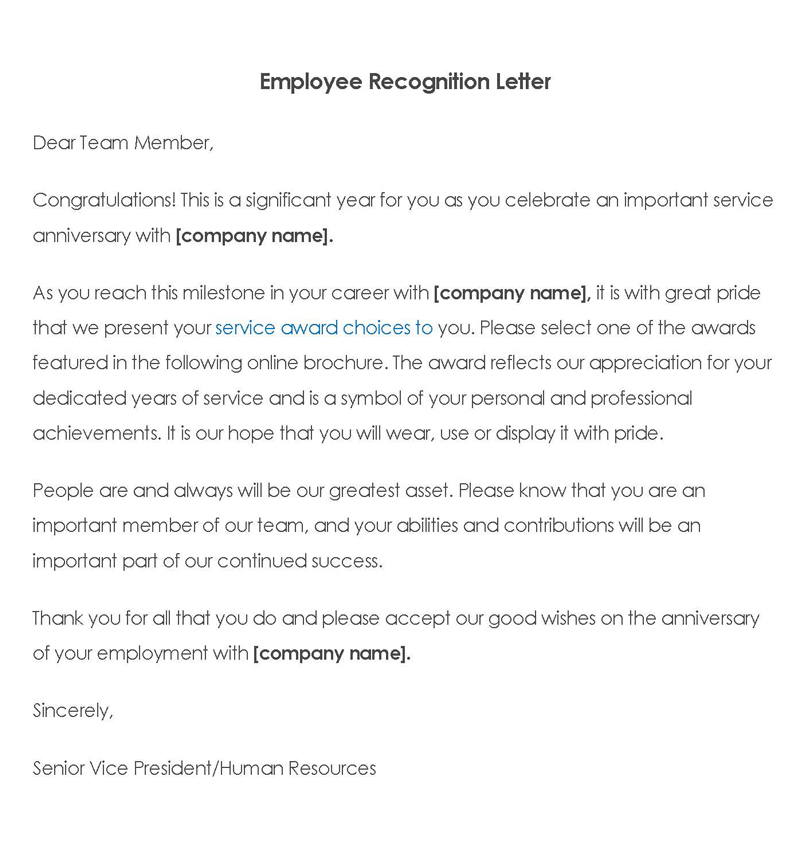
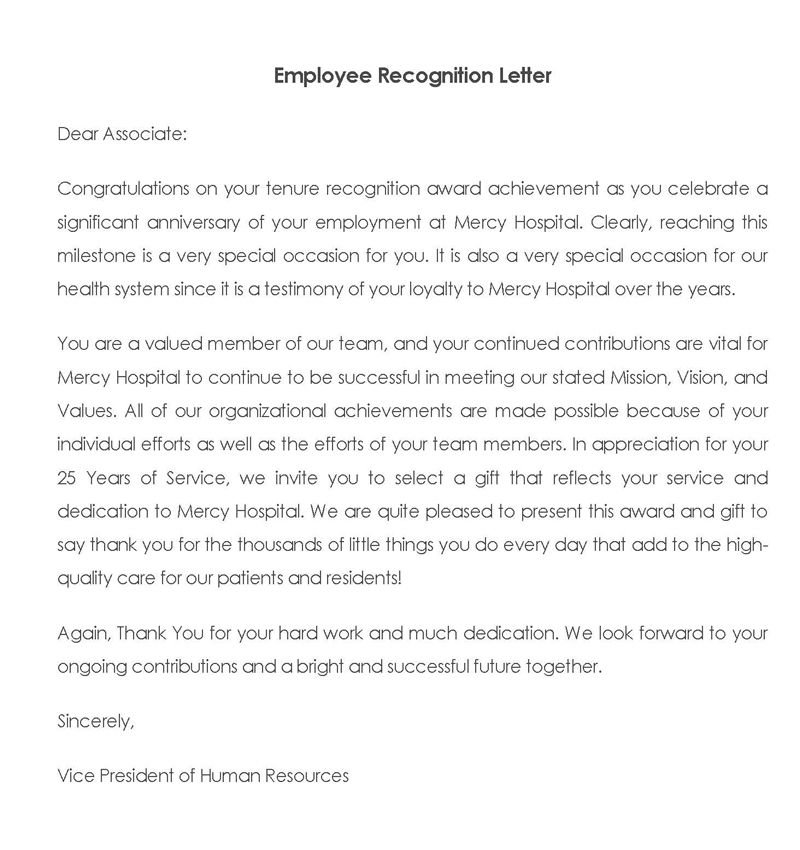
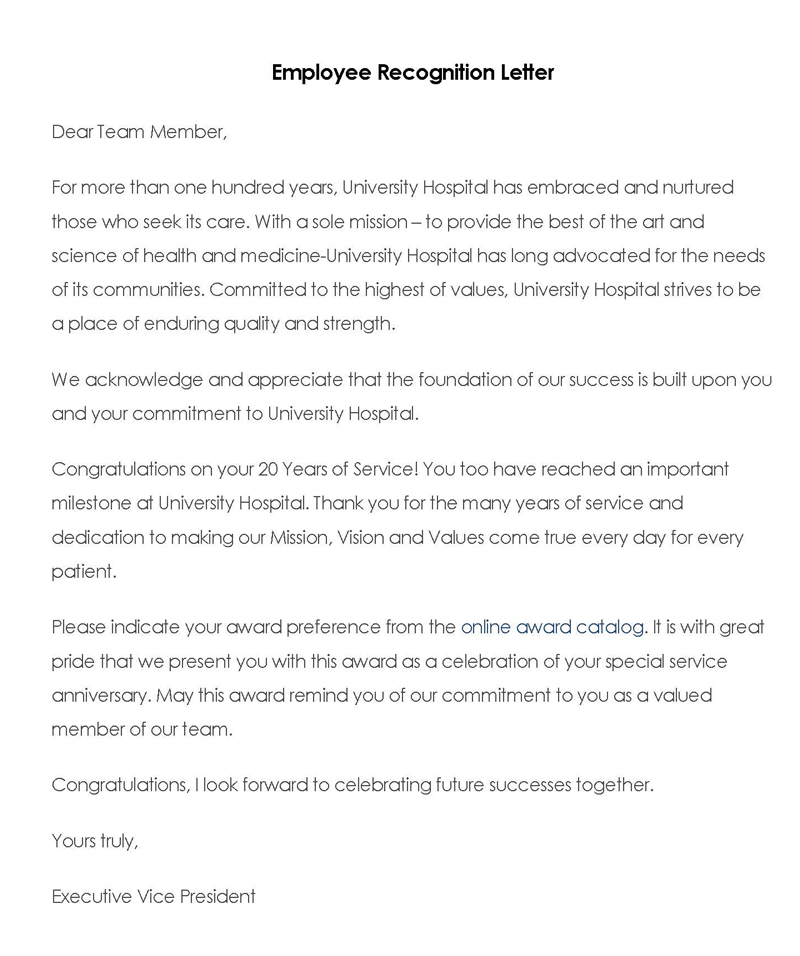
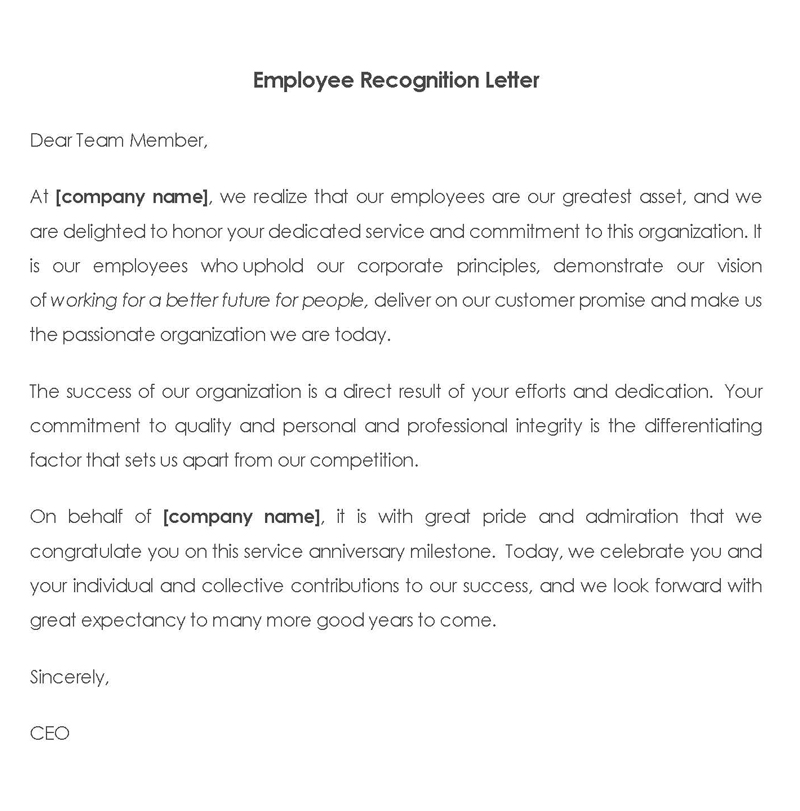
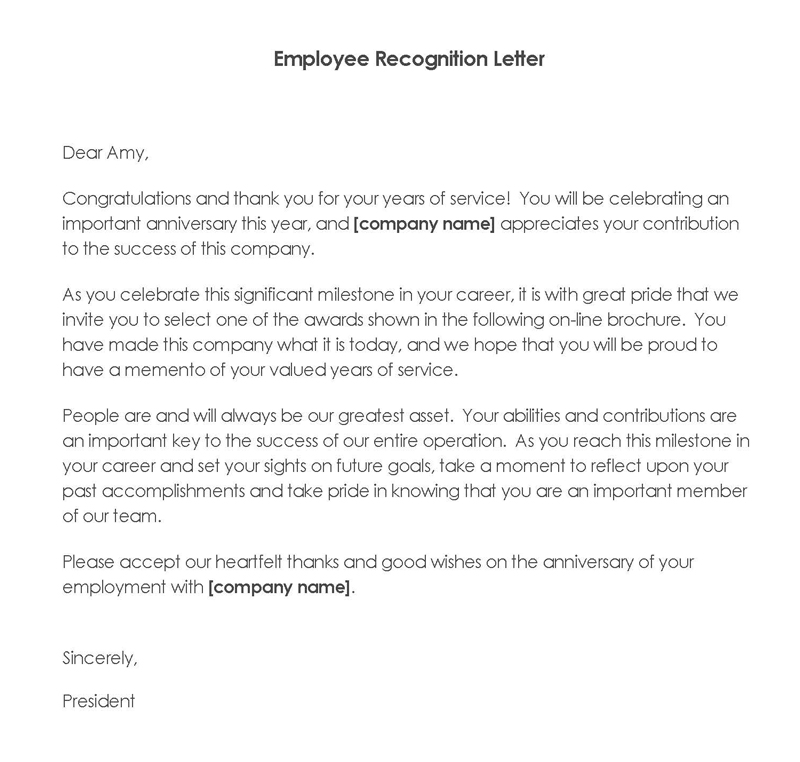
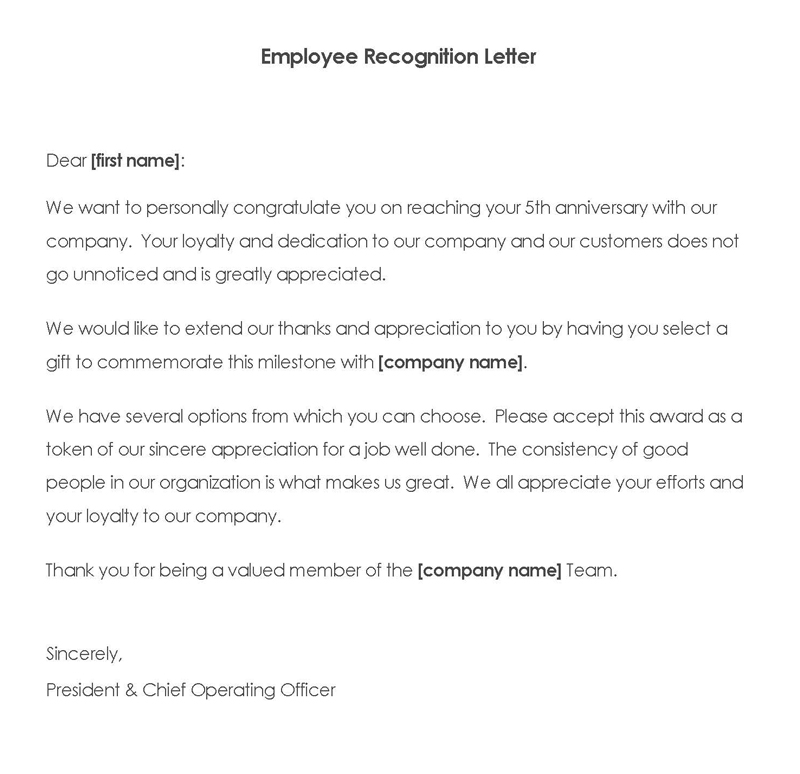
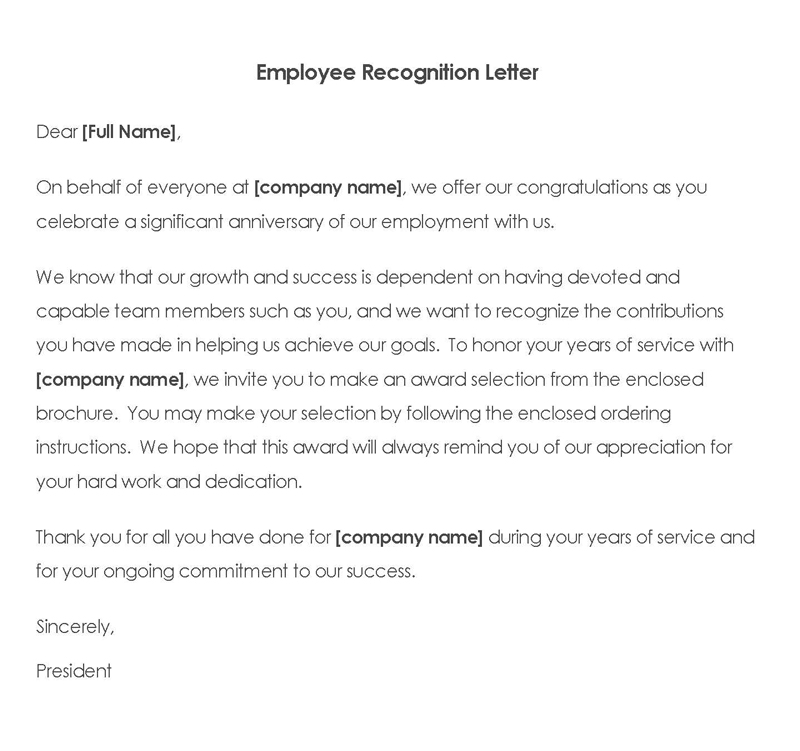
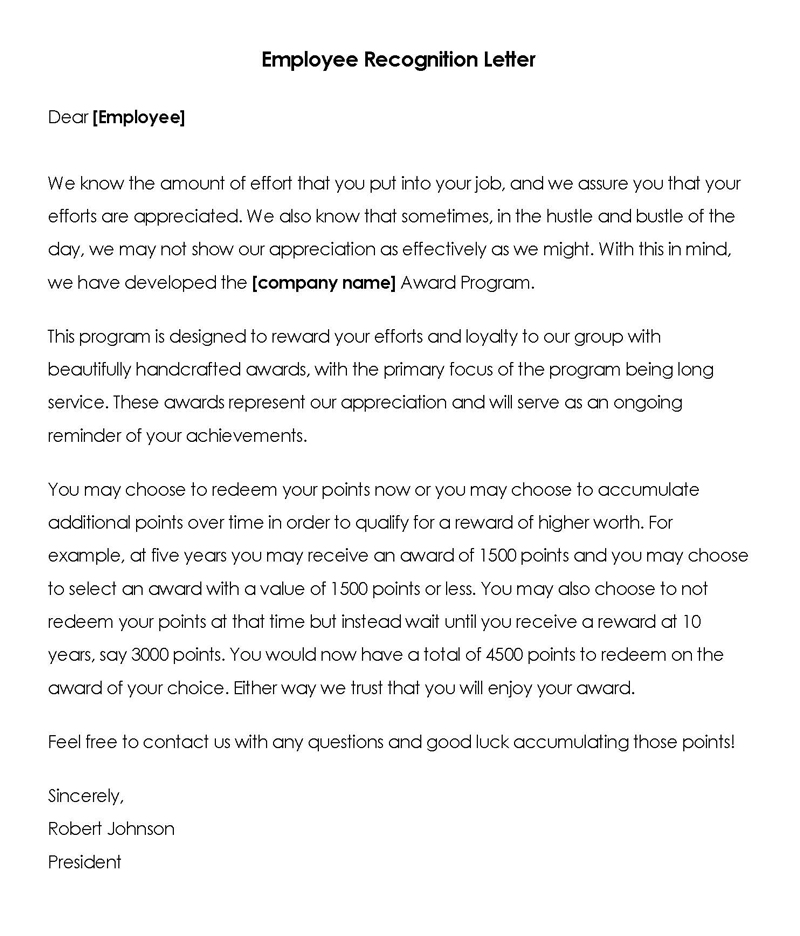
But, Why?
Recognition letters are important because they help maintain a healthy work environment by making every team member feel valued. Considering managers don’t hesitate to criticize a worker, it’s equally important to do the opposite and remind employees that their work is appreciated and valued by the company. Additionally, this type of positive work culture ultimately helps reduce turnover rates and boost overall morale.
Reasons to Write
In general, employee recognition letters are great for showing gratitude and appreciation for another worker’s efforts in the workplace. Though there are many reasons to send a personalized recognition letter to an employee, here is a short list of possible workplace scenarios that deserve mentioning:
To appreciate their hard work
This type of scenario could appear the most often but is also the most overlooked. When you, as a manager, notice that your employees are consistently working hard or even going out of their way to go the extra mile, sending them a quick letter to show your appreciation can go a long way.
EXAMPLE
Dear [name],
The team at the company wants you to know that your hard work has not gone unnoticed, and I would like to show my gratitude for your dedication personally.
Your consistent positive attitude and work ethic set a great example and helped all of us have a better experience in the workplace.
Thank you for all your hard work and enjoy your weekend.
Kind regards,
[Manager name]
To let them know their help matters
When your employee works on a particular project or has carried out some more minor tasks exceptionally well, a quick letter from a supervisor is a great way to give positive reinforcement and make them feel valued for that effort.
EXAMPLE
Dear [name],
I wanted to thank you for taking the time to coordinate and set everything up for the annual staff meeting last Friday.
The entire team was more than pleased with how the event turned out, and I heard several comments about how flawless everything was. I know that you planned and scheduled the entire event, so I wanted to let you know that your hard work has not gone unnoticed.
Thank you again for constantly helping the team.
Happy Monday,
[Manager name]
To appreciate their long-term services
Suppose an employee has been with a company or an organization for an exceptional amount of time. In that case, it’s considered appropriate to send them a recognition letter to thank them for their years of service, especially before they retire.
EXAMPLE
Dear [name],
In case you didn’t already know, I wanted to be the first to congratulate you on your 25 years of dedication at [company name]. You have been a constant source of positivity for the entire team, and your efforts have improved the company’s morale.
The entire management team wants to show you our gratitude for your work over the years, and we are delighted to have had you with us for these past 25 years.
Thank you again, and we hope to continue to be with you for many years to come.
Best,
[Company name]
To appreciate for covering an employee’s leave
Inevitably, a coworker will need to take a leave of absence due to illness, vacation time, maternity leave, etc. Since another employee will typically have an increased workload, it is a nice gesture for a manager to show their appreciation towards that coworker.
EXAMPLE
Dear [name],
I wanted to thank you for all the extra work you have done to help us during [coworker’s name]’s absence. You should know that the hard work you are putting in is highly valued and appreciated.
You were able to take on additional work to help the entire team while still maintaining your regular workload. This is no easy task, and I wanted to express my gratitude for the extra dedication you have shown.
Thank you again, and keep up the excellent work.
Kind regards,
[Manager’s name]
To appreciate their splendid performance
Naturally, when a worker does a great job, that should be pointed out. An employee’s noteworthy overall performance is a cause for celebration and a positive gesture through a letter of recognition.
EXAMPLE
Dear [name],
The entire team at [Company name] wanted to congratulate you on meeting a new sales record during the last quarter. Undoubtedly, you are an excellent team member, and you have something that we can learn from you.
We very much appreciate the time and effort you put into this company, and all of us are better off for it.
Thank you once again for all your hard work.
Have a great week,
[Manager name]
Appreciate their collaboration
Finally, it is often necessary for a team member to go out of their way and collaborate with another department or help someone with a project that is not generally required of them. This extra effort should be pointed out with a recognition letter.
EXAMPLE
Dear [name],
I wanted to take the time to thank you for your collaboration on the [project name].
Your expertise and excellent communication skills helped ensure that the entire process went flawlessly and because of you, the entire experience for everyone was pleasant and productive. In addition, we were able to carry out the project in record time because of you.
Thank you again, and I look forward to continuing working with you in the future.
Best,
[Coworker name]
How to Write an Employee Recognition Letter
Now that the importance of a recognition letter has been established, it’s time to go over the exact writing process. Several components should be included, as follows:
Header
Firstly, an appropriate header needs to be chosen based on the format you would like to select. For example, if you send an email to the employee, a more formal company header or signature line could be appropriate, while a handwritten note might not need one.
- Date: In the top left corner of the letter, specific information should be included. For example, one of the first pieces of information should be the date when the manager is writing the letter.
- Employee’s name and contact information: The employee’s name and contact information should also be included. This is simply standard practice for any company’s inner correspondence and helps maintain a level of professionalism.
- Your name and contact information: Next, it’s essential to include your name and contact information so that the employee knows from whom the letter is coming. Especially in the case of a printed or physical letter, this guarantees transparency and clarity.
Introduction
It is always essential to include a clear introduction that concisely states the purpose of the letter. This could be as simple as writing a “Letter of Recognition” or “Congratulations Letter” before starting the main text. It should clearly describe the reason for writing.
- Greetings: You can include any greeting that you wish, if it is appropriate. For example, simply writing “Dear [name]” is more than sufficient in most situations. However, if you want the letter to be less formal, you could also include greetings such as “Hi [name]”, for example.
- Opening statement: The very first line of the text should also briefly mention the purpose of your writing. In other words, a recognition letter should start by explicitly mentioning why you are thanking this employee. For example, you can mention their collaboration or their strenuous efforts and say a quick thank you.
Body
The body of the letter is ultimately the most crucial section. This part should be more personal and should include specific examples of the work they’ve done. It’s also important to be careful of your word choice, as you want to express gratitude while still maintaining a level of professionalism.
- Express your appreciation: Within the body, you should express your gratitude for the specific work. You can write this by simply stating that you appreciate their work.
- Reinforce their behavior: Of course, one of the biggest goals of writing a letter of recognition is hoping that the employee will continue to exhibit exemplary behavior. Therefore, it is fundamental to include positive reinforcement that will encourage the employee to repeat that behavior.
- Express gratitude with examples: Another great way to express your gratitude is by showing examples of how exactly you appreciate them. Being as specific as possible with examples ensures that the worker knows you are content with your actions.
- Support their services: You can also mention how you would like to support them as they continue forward in the company. For example, you can mention how you look forward to working with them again on a future project.
- Write about the positive qualities of an employee: During the recognition letter, you should also mention the employee’s positive qualities. This improves the overall impression of the letter and makes it seem a little more personal.
Conclusion
The conclusion can be straightforward. However, you’ll want to bring the text to a natural conclusion by summing everything up or by mentioning your appreciation once again.
- Conclude by announcing a reward, bonus, or appreciation: Additionally, if the letter of recognition is just the tip of the iceberg, you can let them know at the end about any possible rewards or bonuses. If you are exceptionally pleased with their yearly performance, for example, the letter could serve as a basis to inform them about a potential raise or promotion.
- Sign off on the letter: Finally, make sure to include an appropriate signoff and include your name and job title. This information makes it clear who exactly is praising their behavior. This also helps maintain the level of professionalism.
Employee Recognition Letter Template
[Employee’s full name]
[Employee’s address]
[Employee’s Phone number]
[Employee’s Email]
[Date of the letter]
[Author’s full name]
[Company name]
[Company address]
[Greeting],
[Opener that expresses the reason for writing]
[Body of the letter giving all the details about why you are thanking the employee]
[If necessary, mention any possible raises/rewards]
[Closing statement to sum up and restate gratitude]
[Signoff]
[Author’s full name]
[Signature]
[Author’s job title]
Sample Employee Recognition Letter
Dear Emily Turner,
I am writing to you today to express my sincere gratitude and appreciation for your outstanding contribution to our team, especially during the recent launch of our flagship product, ZenithPro. Your dedication and hard work have not gone unnoticed, and it is my pleasure to recognize your achievements.
Your commitment to excellence has been evident in your leadership role in the ZenithPro project. Your ability to collaborate effectively with your colleagues, especially under tight deadlines, and your unwavering dedication to achieving the best possible results have been a significant asset to our marketing team.
I am particularly impressed by your innovative approach to the digital marketing campaign, which significantly increased our customer engagement by 40%. This example highlights not only your professional skills but also your dedication, creativity, and teamwork. Your efforts have not only contributed to the project’s success but have also set a high standard for your peers.
As a token of our appreciation, I am pleased to announce that you will receive a bonus of $1,000 and an extra two days of vacation. This is a small gesture to acknowledge your exemplary performance and the value you bring to our team.
In closing, I would like to reiterate my gratitude for your hard work and dedication. Your contributions are an essential part of our success, and I look forward to your continued excellence. We are fortunate to have you on our team, and I am excited to see your future achievements at Acme Solutions.
Thank you once again for your exceptional efforts.
Sincerely,
Michael Roberts
Vice President of Marketing
Acme Solutions
Key takeaways
The provided letter is a strong example of an appreciation letter written in a professional context. Here’s an analysis of its key elements and usefulness for someone seeking guidance on how to write a similar letter:
- The letter starts with a clear address to the recipient and swiftly moves to state its purpose – expressing gratitude and appreciation for the recipient’s contributions. This direct approach is effective as it immediately informs the recipient of the letter’s intent.
- The body of the letter highlights the specific achievements of the recipient. This level of specificity is crucial in making the appreciation feel genuine and personal. It shows that the sender has paid close attention to the recipient’s work and its impact.
- The letter explicitly mentions various skills and attributes of the recipient. This not only boosts the morale of the individual but also serves as a record of their competencies, which can be motivating and helpful for their career progression.
- The letter mentions a tangible reward (bonus and extra vacation days) as a token of appreciation. It not only recognizes the employee’s efforts but also incentivizes high performance among other team members.
- The conclusion reiterates gratitude and expresses eagerness to see the recipient’s future contributions. It ends on a positive note, reinforcing the sender’s appreciation and support for the recipient’s career.
- The letter concludes with a formal sign-off. This adds a professional touch and makes it easy for the recipient to respond or contact the sender if needed.
Professional Tips for Writing
Even though you can use the above template to fill out a letter of recognition, you can still use the following tips to make the letter adequate and appropriate:
Be specific
Make sure that the letter mentions the actions the employee has carried out to warrant recognition. You can be specific by stating exact examples of their hard work and explaining why you are thankful for their hard work.
Don’t lie
It’s essential to be honest and genuine in your letter. Of course, you don’t need to be dishonest with your letter of recognition. However, if you are going out of your way to demonstrate your gratitude, you should do so sincerely.
Focus on their strengths
It would be best if you also mention the positive aspects of their personality or work ethic. Anything that the company finds valuable can be included so that the employee knows that they, as a person, are respected and appreciated.
Use a professional tone
Even though you’re thanking the employee, you should maintain a level of professionalism consistent with your management position. This means that the tone can be positive while remaining at least semi-formal.
Consider their future
One main reason for these letters is to encourage the employees to continue their efforts within the company. Additionally, any possible rewards that stem from their hard work can also be mentioned.
Proofread your letter
Make sure to proofread your letter extensively before sending it. Of course, you want to avoid sending a letter with any grammatical errors or choppy flow. One great technique is to read it aloud to make sure the tone is appropriate.
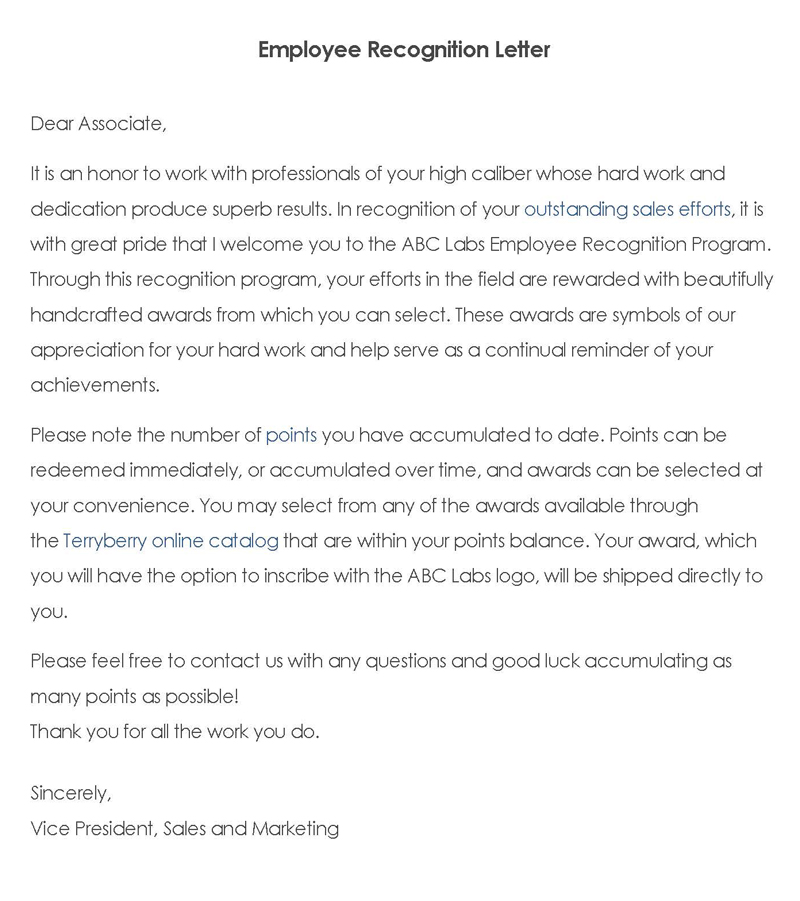
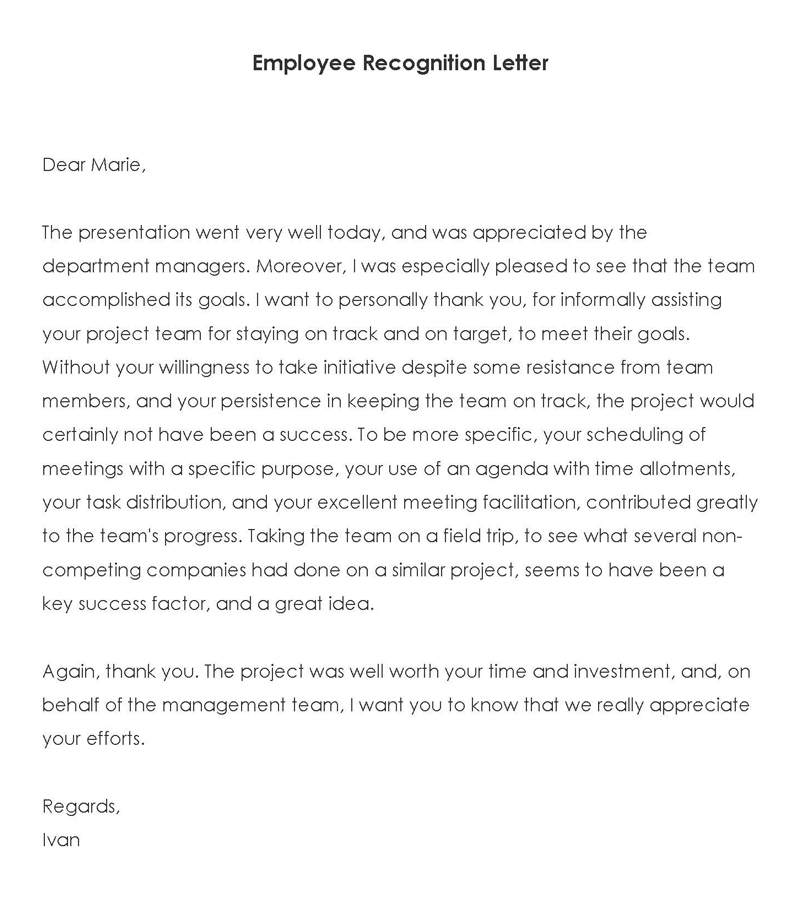
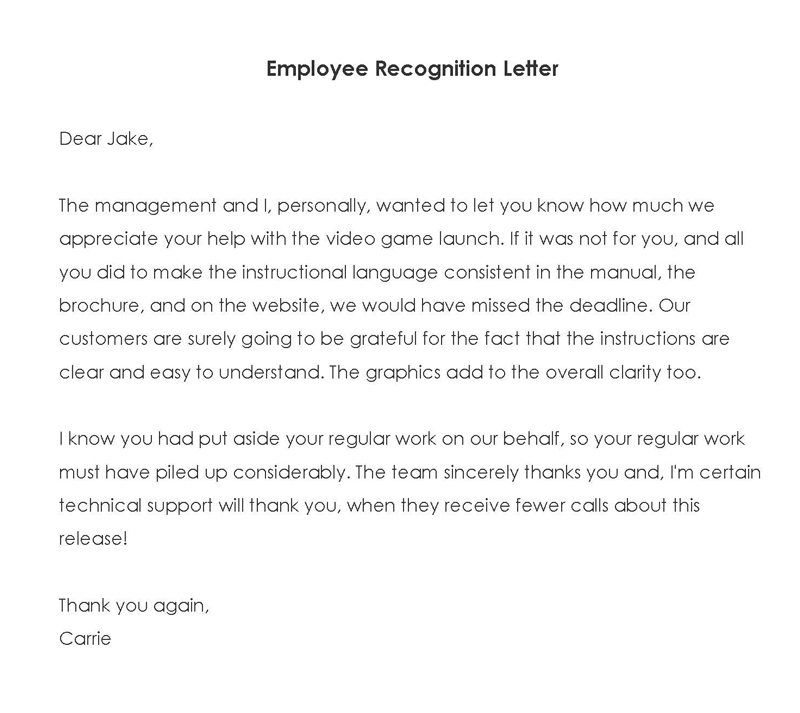
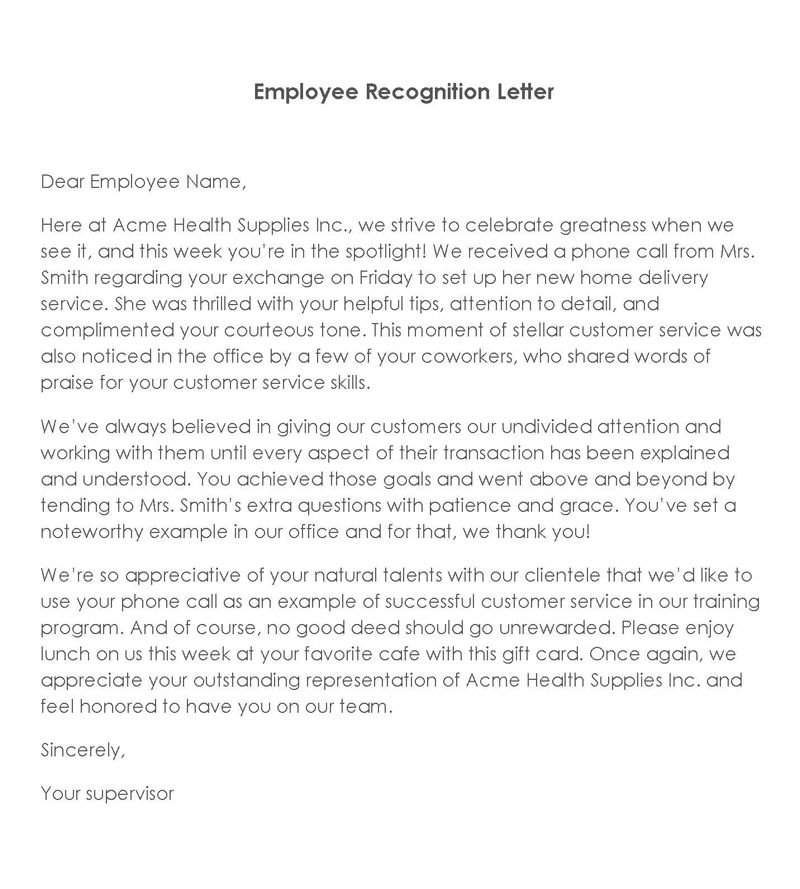
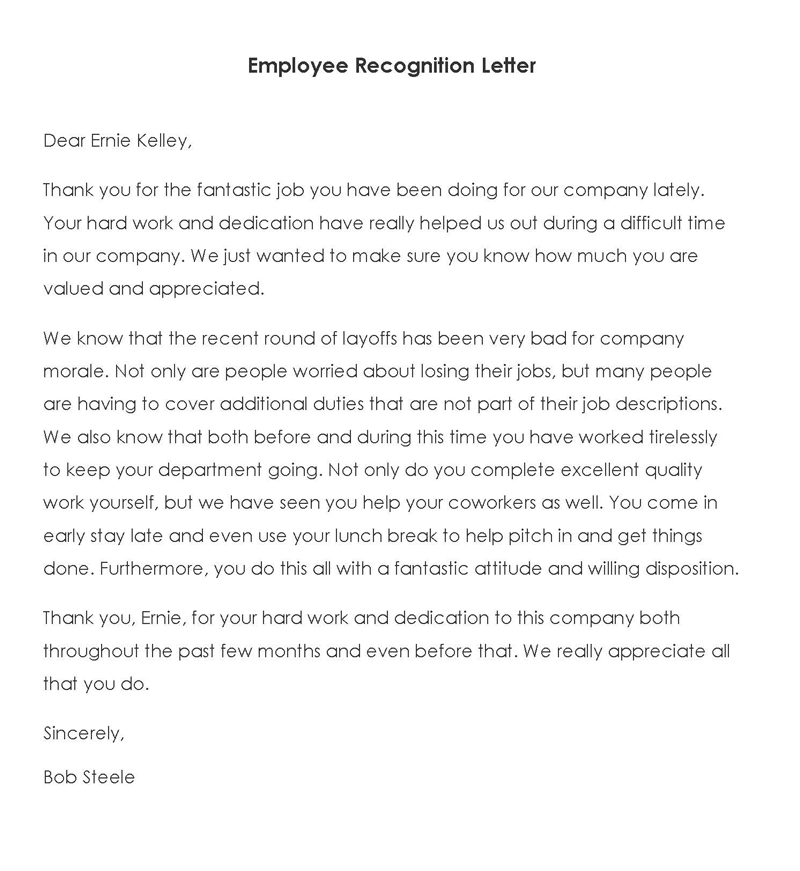
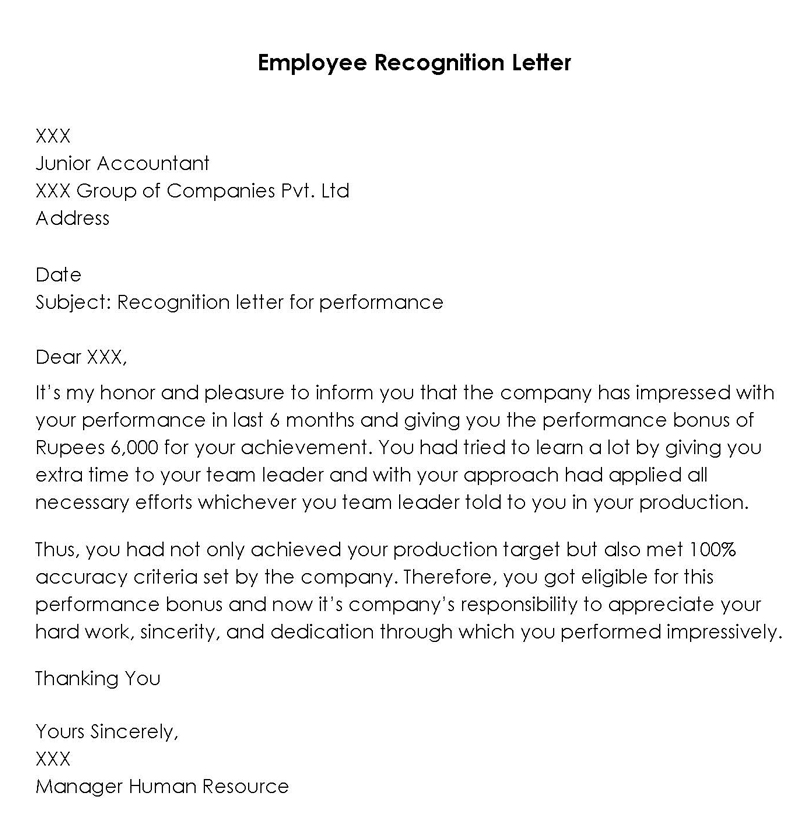
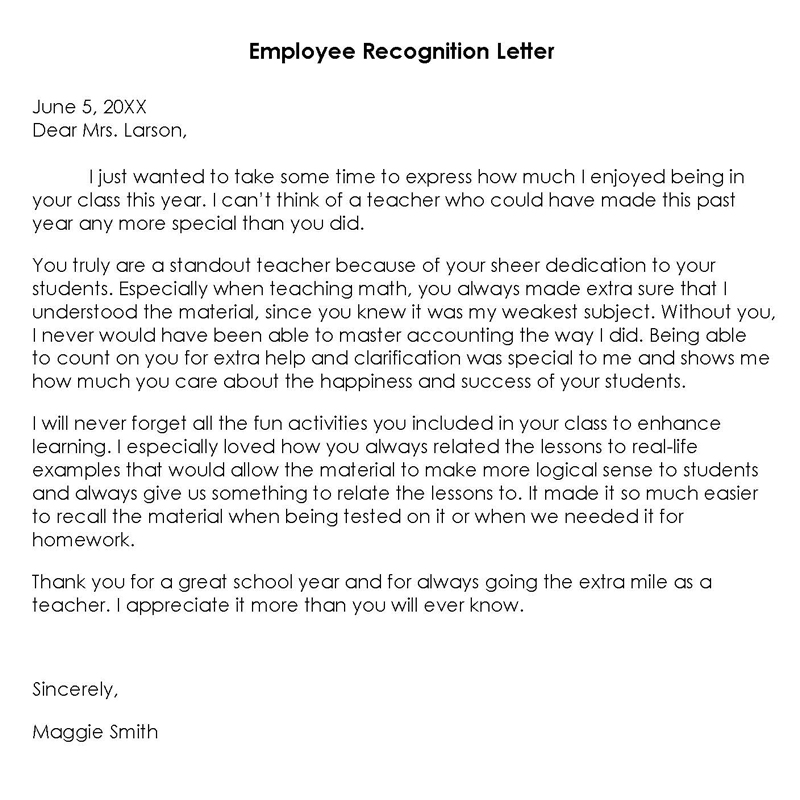
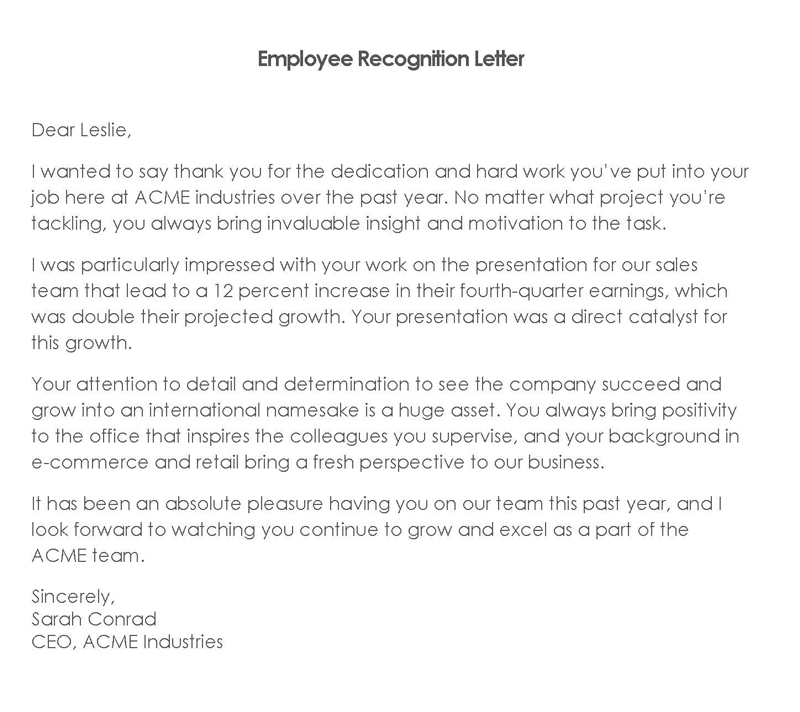
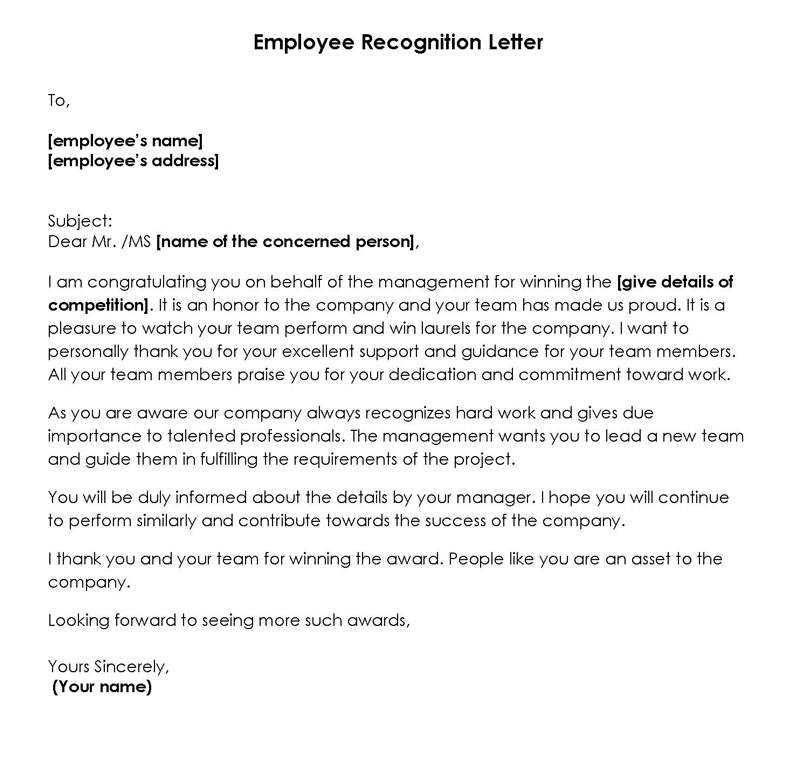
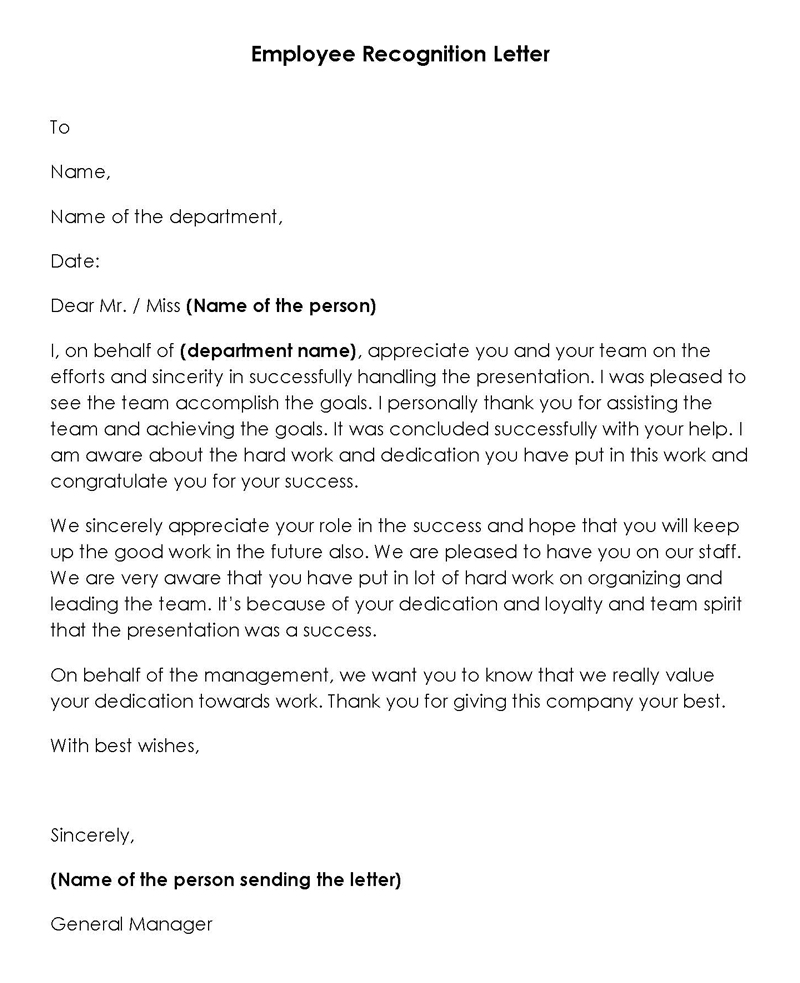
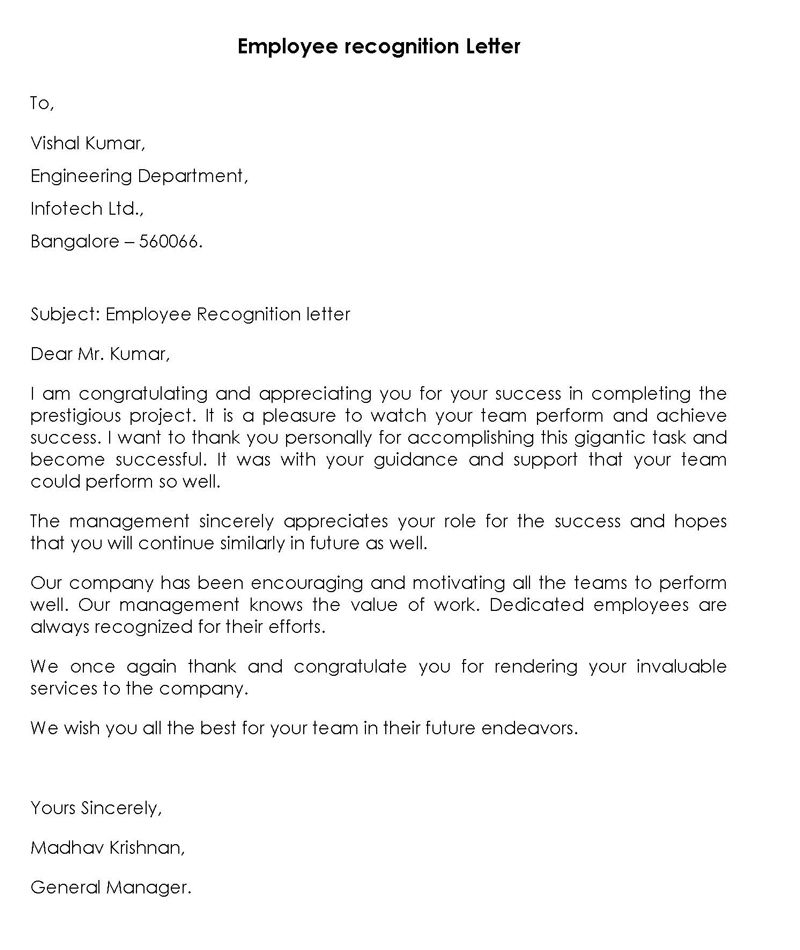
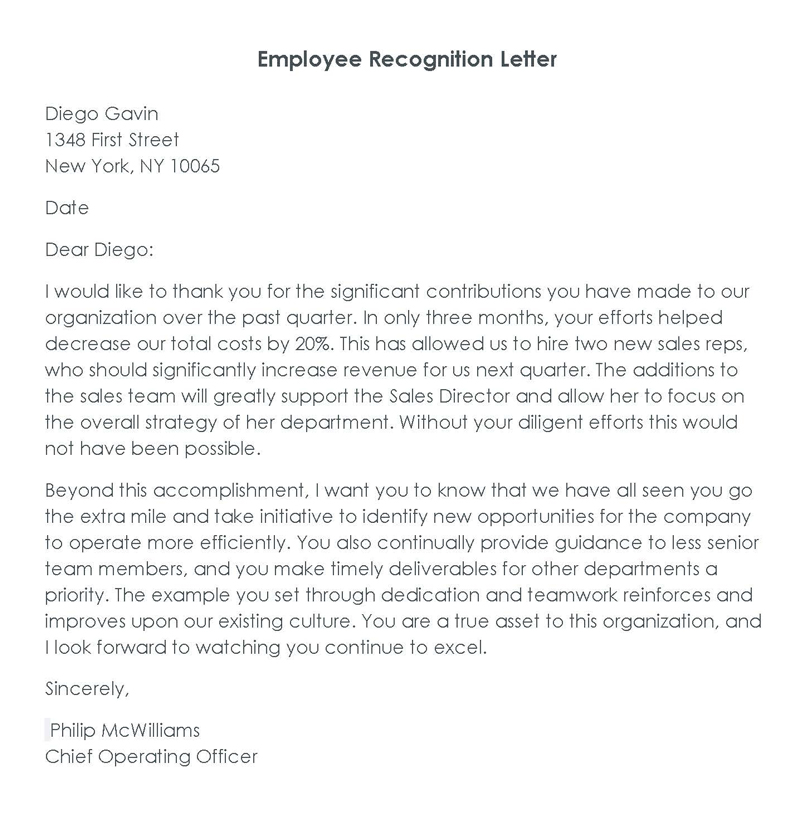
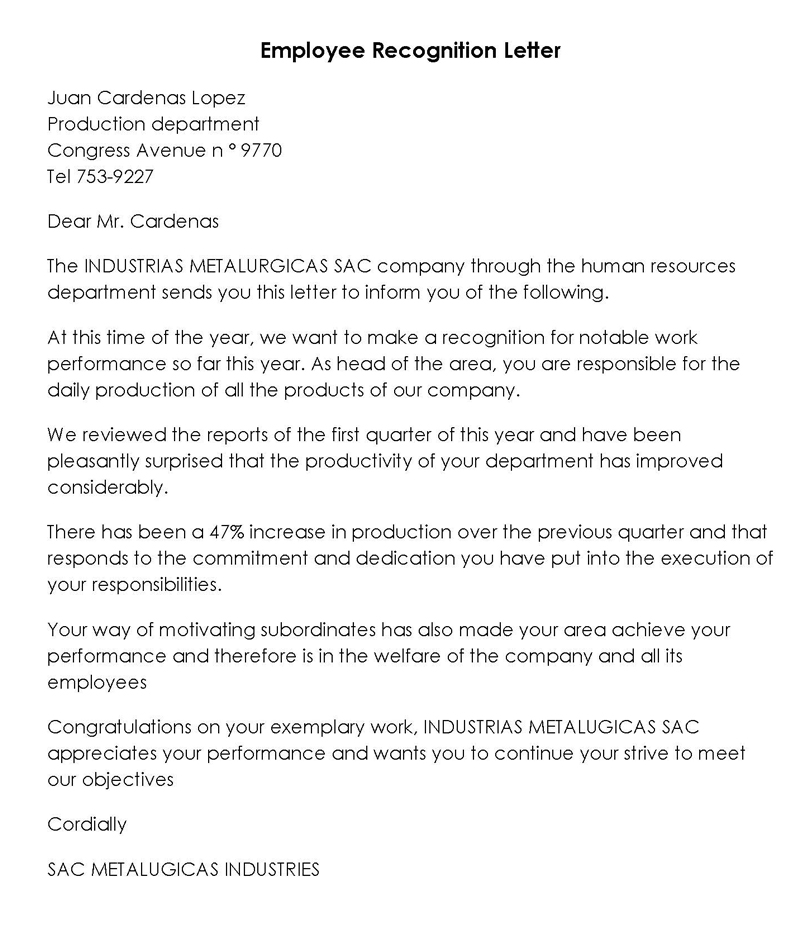
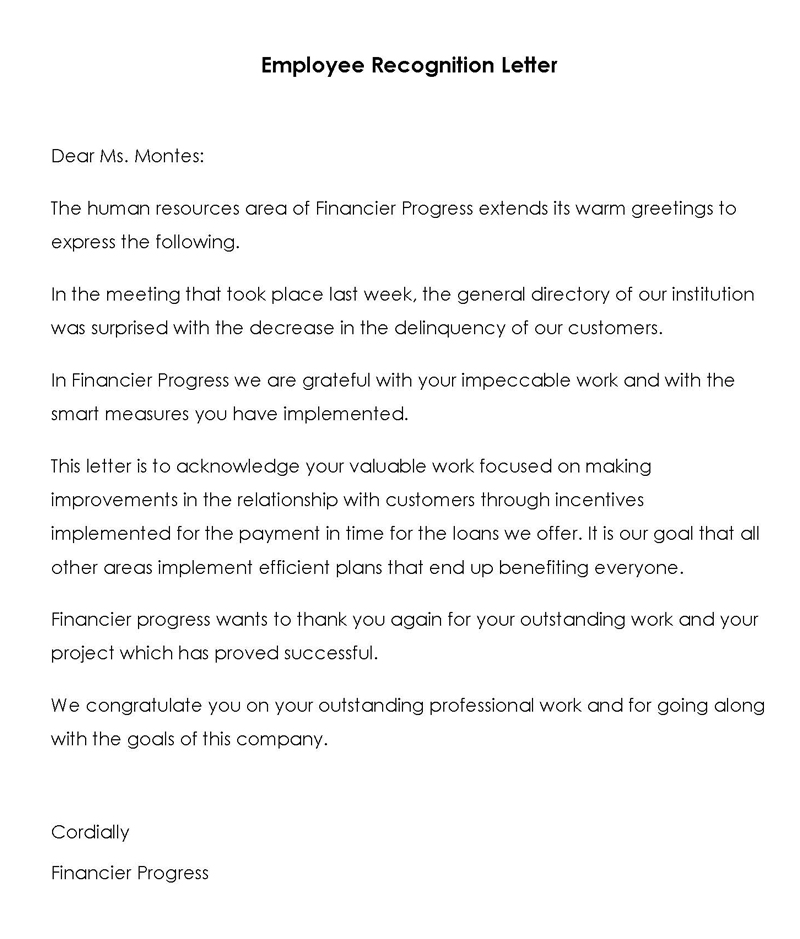
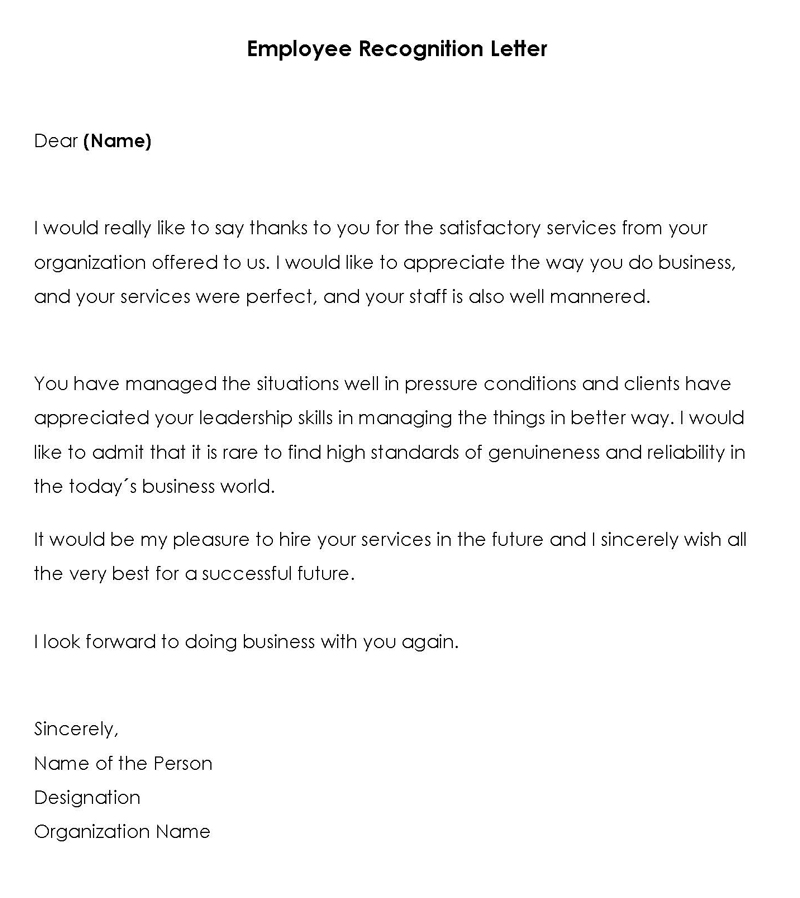
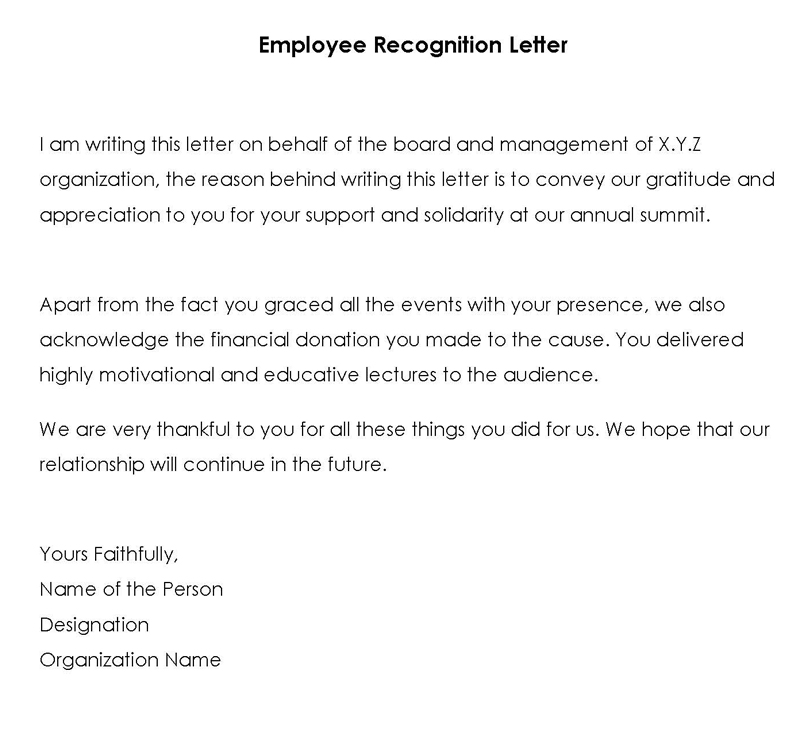
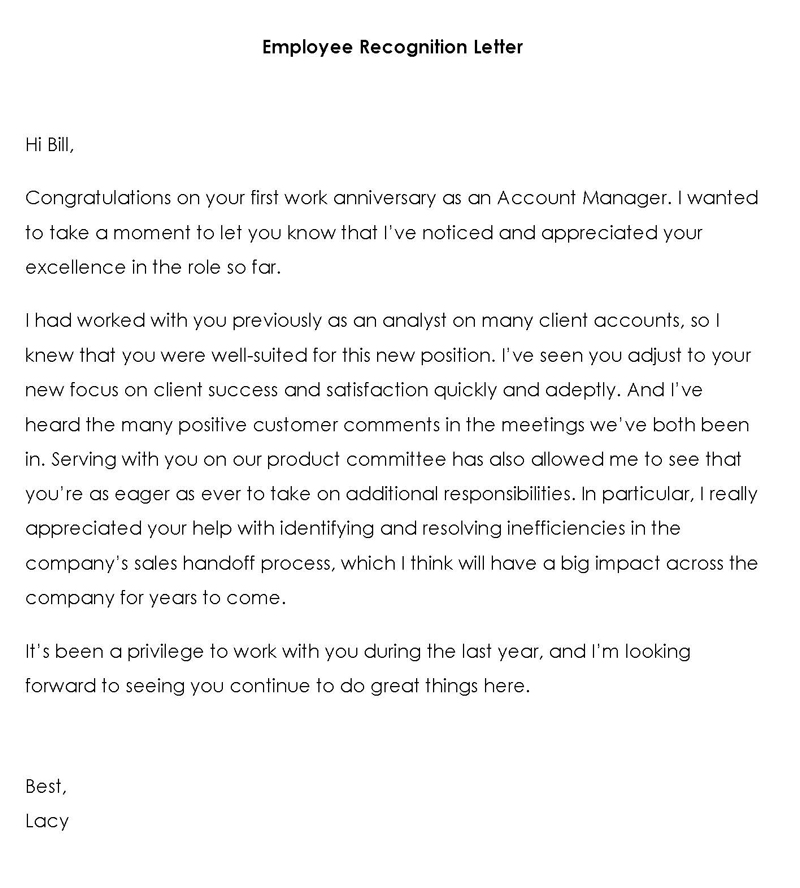
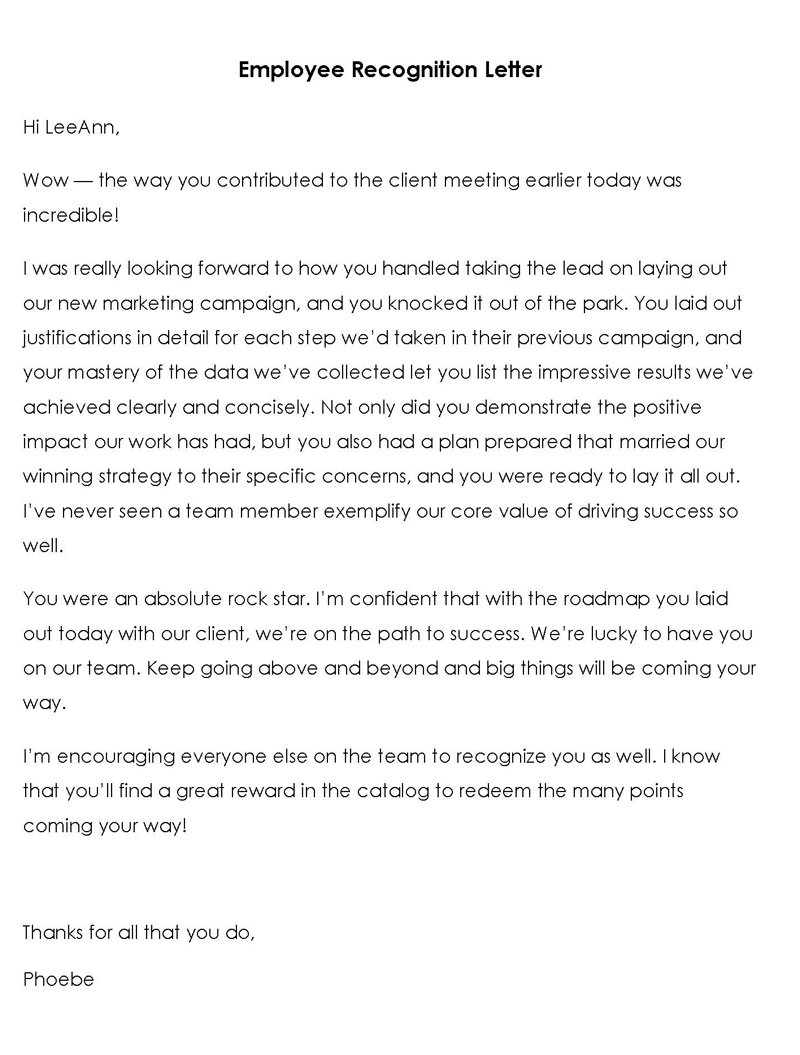
Frequently Asked Questions
Firstly, the letter should be formatted appropriately by including the corresponding contact information, Greeting, and closing. It should also include a specific description of the employee’s actions that you are expressing your gratitude for. Next, it should include an evident appreciation for their dedication and contribution to the team.
A recognition letter can be sent for a range of situations. For example, you can use it to thank an employee for going the extra mile, helping a coworker, or volunteering to do extra work to help the team, and many more.
Typically, any employee leader within the team should write this letter, such as managers or supervisors. However, coworkers can also send recognition letters to help promote a positive workplace environment.












